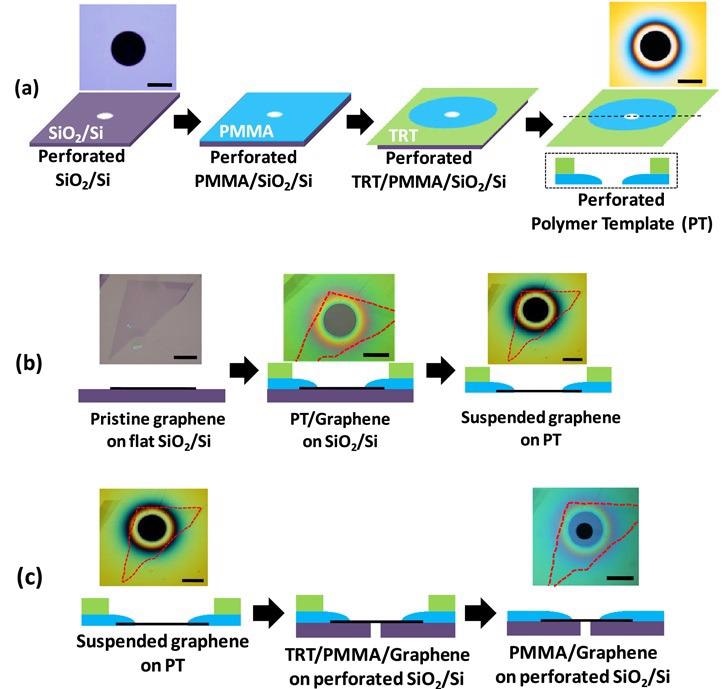In a study published recently in the Journal of Nanotechnology, a new technique has been proposed to prevent residue and contamination of 2D materials when being transferred.

Study: Residue-free suspended graphene transferred by perforated template. Image Credit: megaflopp/Shutterstock.com
What is Graphene?
Graphene and certain other two-dimensional (2D) components have unusual properties and are still of curiosity in many scientific fields due to their potential uses in optoelectronics, high-temperature superconductors, wearable electronics, fuel cells, genetic analysis, as well as other fields.
Nevertheless, to use two-dimensional tools efficiently, the transmission from reference material to a component surface is required for both hardware manufacturing and property categorization.
Just about all currently accessible methodologies for components transmission use carrier polymeric materials which either wrap or come into thorough interaction with the conductive polymers.

Figure 1. Schematic of the transfer method for the fabrication of suspended graphene using perforated templates. (a) Preparation of the perforated polymer template (PT). (b) Transfer of graphene on the PT. (c) Transfer of graphene on the perforated SiO2/Si substrate. (scale bar is 20 μm). © Kim, S. M. et al. (2022).
Different Transfer Methods
Transmission polyesters are commonly used for wet movement and are usually attributed to the skin of two-dimensional materials via spin-coating.
Following the phase transition, these transmission plastics are dispersed using either particular etchants such as acetonitrile or by thermal degradation at elevated heat in the range of oxidizers.
Nevertheless, it is well renowned that even after continuous engraving in different solvents preceded by enhanced growth heat treatment, it is exceedingly hard to truly eliminate these polymer carriers from the exterior of two-dimensional materials, resulting in significant polymer contaminants on the exterior of the two-dimensional materials.
These contaminants can negatively influence the functioning of conjugated polymers.
Transfer Methods for CVD-Graphene
Additional transfer methods for huge CVD-graphene without thermoplastic have earlier been suggested for huge CVD-graphene. This can be achieved by explicitly engraving the fundamental Cu sheets, by moisture technique, by using organic solvent rather than polymer carrier, or by clear debonding of graphene with H2 bubbles and so forth.
However, using these methodologies to fabricate residue-free locked up two-dimensional materials on a porous medium is challenging because the dissolved two-dimensional components are damaged by the surface tension applied by the fluids used during the wet transmission.
Nonetheless, using wet transmission methodologies, a few ways of making suspended graphene with no polyethylene impurities have been recommended.
The majority of these technique involves straightforwardly putting CVD-graphene/copper foil onto the transmission electron microscopes grid without the need for a polymer carrier. The dissolved graphene on the transmission electron microscopes grid is acquired by etching copper foil.

Figure 2. Images and illustrations of the separation of graphene/PT from SiO2/Si substrate. (a) Successful case and (b) unsuccessful case. (scale bar is 50 μm). © Kim, S. M. et al. (2022).
Limitations of Previous Techniques
Even though these techniques can reduce the power of polymer contaminants, the region of dissolved graphene is extremely small and is restricted to elevated transmission electron microscope measurements.
Such techniques, in general, and especially, typically use huge CVD graphene, and the dissolved graphene is acquired haphazardly or stochastically by a material with numerous openings, making it hard to algorithmically transfer small-area graphene, to the target place in a ruptured material.
Proposed Methodology
Aside from the substrate interaction, polyethylene contaminants can harm the productivity as well as the properties of two-dimensional materials. As a result, any polymer must not be placed in areas that are being used or checked to prevent negative influences.
To avoid polymer accumulation in the target gene, a novel transfer technique was established for transferring graphene as well as other two-dimensional substances onto target surfaces that are free of polymer contaminants in particular and pre-selected territories.
Graphene can be directly moved and suspended over multiple lengths of openings, ditches, and holes utilizing prefabricated ruptured polymeric layouts, eliminating the necessity of spin-coating or encompassing broad graphene with a thermoplastic.
Even though the proposed technique can also be classified as a parched carrier system, it was able to make huge dissolved graphene with no polymer impurities, irrespective of whether the graphene is CVD or immaculate.
The new framework is believed to enhance the two-dimensional material and coating research communities by making it easier to explore the unique characteristics of two-dimensional materials without having to think about the effects of synthetic polymer contaminants and nutrient engagement.

Figure 3. TEM analysis results. (a) TEM image of graphene (TEM grid is inset). (b) High magnification TEM image (fast Fourier transform pattern (FFT) is the inset). (c) Conventional PMMA-based transfer technique where the polymer residues fully cover the graphene surface (FFT pattern is inset). © Kim, S. M. et al. (2022).
Research Conclusion and Prospects
In conclusion, a new graphene transmission technique was suggested that allows to precisely and explicitly transmit graphene onto the target substrate without synthetic polymer contaminants and create false suspension frameworks over openings, ditches, and discrepancies.
It was conclusively achieved that immaculate graphene could be directly transmitted on the ruptured SiO2/Si substrate without polymer expulsion and thermal degradation using a pre-engineered polymer framework with a pre-configured sequence.
Light microscopy was used to examine the filtration of the PT/graphene from the SiO2/Si substrate in greater depth.
Reference
Kim, S. M. et al. (2022). Residue-free suspended graphene transferred by perforated template. Nanotechnology. Available at: https://iopscience.iop.org/article/10.1088/1361-6528/ac4664
Disclaimer: The views expressed here are those of the author expressed in their private capacity and do not necessarily represent the views of AZoM.com Limited T/A AZoNetwork the owner and operator of this website. This disclaimer forms part of the Terms and conditions of use of this website.